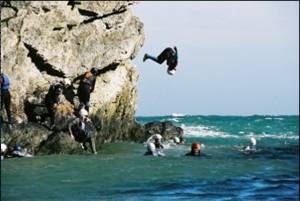Portmeirion Village and Gardens, Wales
Details
Historic Buildings and Monuments, Tours and Trips, Visitor Centres and Museums
Address:
Opening Hours:
PORTMEIRION is open to day visitors every day of the year except Christmas Day. Hours of opening: 09:30 - 17:30 (from September to March) 09:30 - 19:00 (April - Septembe Admission Charges 2009 Adults £7.50 Concessions £6.00 (Students, Senior Citizens, Unwaged) Children £4.00 (up to 16, under 5s free)Portmeirion Village and Gardens Stately Homes in Minffordd between Penrhyndeudraeth and Porthmadog, Gwynedd, Wales
Portmeirion was by Gerald of Wales in 1188:
Gardens of Portmeirion
Before anyone took an interest in developing the Portmeirion Peninsula, the natural vegetation would have been sessile oak with birch, rowan and locally in wet areas alder and willows. The soil would have been a thin skeletal, acidic brown earth on Cambrian shales and grits which would have dried out very quickly as it does today.
The climate is very mild , winter frosts are rare and this has allowed plantings of tender exotic genera and species in common with many Cornish gardens.
The first plantings, were in early Victorian times. Henry Seymour Westmacott in the late 1850's was responsible for most of these.
From this era a few specimen conifers still survive, large Douglas Firs, Coast Redwoods, Wellingtonia, Noble and Himalayan Firs, and a Deodar which is once more, growing well, a distinctive type of Scots Pine (quite different from later plantings).
The coastline is dominated by rugged, fine Monterey Pines, with a key Scots Pine in the Village. Notable trees in the Village from this era are a Tulip Tree, a massive Variegated Sycamore, a Weeping Silver Lime, which scents the Village in August, and large Beech and Bay Trees.
Around the Hotel, are large trees of the evergreen Holm Oak. Portugal and Cherry Laurels, Strawberry Tree, Rhododendron ponticum, Yew, Bay and Laurustinus illustrating the Victorian passion for evergreen plantings. In the woodland there is a very large specimen of Griselinia littoralis (known as 'The Dancing Tree') and an outlying group of Monkey Puzzles.
The Edwardian Period
Caton Haigh was responsible for a further extensive phase of planting. With the purchase of an additional piece of land on the north and west, 'The Gwyllt', a display woodland, was developed. Here were concentrated the major Rhododendron, Azalea and Camellia plantings with a wide variety of choice trees.
These now include a large (though later) Magnolia campbellii which is now spectacular at Easter with its enormous pale pink flowers, several good Maidenhair Trees (Ginkgo biloba), with fine Chrome-Yellow autumn colour; the Winter's Bark (Drimys winteri), the scarce Plagianthus betulinus; and the evergreen, willow-like Maytenus boaria which is probably the largest in Britain. At the same time Haigh planted shelter-belts, and developed the structure of the woodland which remained the same until the late 1970's. His gardener Alfred Blount was responsible for much of these plantings and these carried on after the 1940 purchase of The Gwyllt, into the 1950's; thus providing continuity.
Clough Williams-Ellis had acquired the Village and Victorian Wood in 1926 but Haigh's Gwyllt not till 1940. He concentrated mainly on the Village with planting of trees for shaping (especially Irish Yews), Cabbage Palm (Cordyline australis), for exotic effect, hedges and pleached trees.
In the woodland considerable structural alterations were made; avenue plantings; the construction of the two lakes, and with the planting of the formal entrance hedge (with vistas) in the first part of the woodland. Emphasis was on structure rather than detailed content. Paths were maintained, but the dense growth between was allowed to develop, largely unchecked, with only minimal clearing and replanting.
Recent Developments
Since 1980 a major renovation programme has been begun, with much clearing, restructuring (especially the lakes, which have been re-dug and reshaped) and extensive replanting throughout the woods.
Nearby Holiday Accommodation

Taliesin
Pet & Dog Friendly
From £ 364.00 p/week

The Penthouse
From £ 606.00 p/week

Glandwr
Pet & Dog Friendly
From £ 633.00 p/week

5 Ivy Terrace
From £ 533.00 p/week
Location Details and other Things to Do
Nearby Things to Do

Portmeirion village and gardens
Gwynedd, Wales

Snowdon Mountain Railway
Gwynedd, Wales

Redline Indoor Karting
Gwynedd, Wales

Harlech Castle
Gwynedd, Wales

Surf-Lines Adventures & Shop in Snowdonia Wales
Gwynedd, Wales

Caernarfon Castle
Gwynedd, Wales

St Davids Golf Course
Gwynedd, Wales

Snowdonia Guides Ltd
County of Conwy, Wales

Fairbourne Steam Railway & Rowen Nature Reserve
Gwynedd, Wales

Bach Ventures
Gwynedd, Wales

Penmachno Mountain Bike Trails
County of Conwy, Wales

Nefyn & District Golf Club
Gwynedd, Wales
Nearby Accommodation Holiday Accommodation in Wales

Taliesin
Pet & Dog Friendly
From £ 364.00 p/week

The Penthouse
From £ 606.00 p/week

Glandwr
Pet & Dog Friendly
From £ 633.00 p/week

5 Ivy Terrace
From £ 533.00 p/week

Llannor
From £ 411.00 p/week

Ty'r Ysgol
Pet & Dog Friendly
From £ 496.00 p/week

Garth Morthin The Barn Self Catering Accommodation Morfa Bychan Wales >
Pet & Dog Friendly Online Booking Accepted
From £ 729.00 p/week

Garth Morthin The Stables
Pet & Dog Friendly
From £ 484.00 p/week

Cefn-Yr-Efail Self Catering Cottage Golan Wales >
Pet & Dog Friendly Online Booking Accepted
From £ 444.00 p/week

Groes Newydd
Pet & Dog Friendly
From £ 326.00 p/week

Groes Newydd Bach
Pet & Dog Friendly
From £ 313.00 p/week

Is Y Deri
From £ 697.00 p/week

